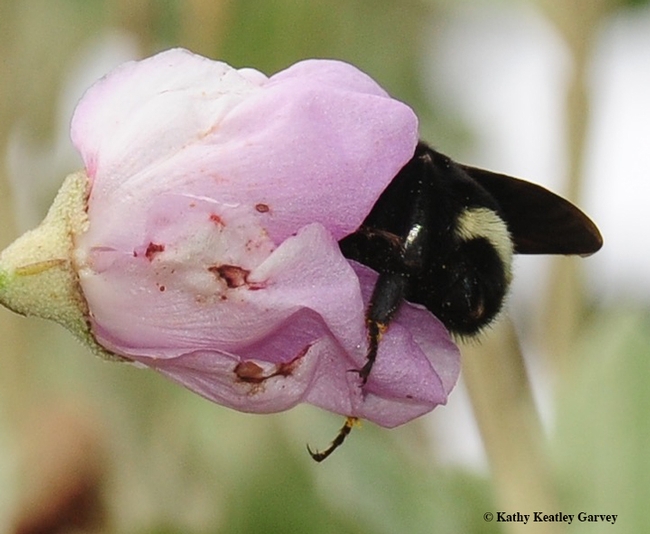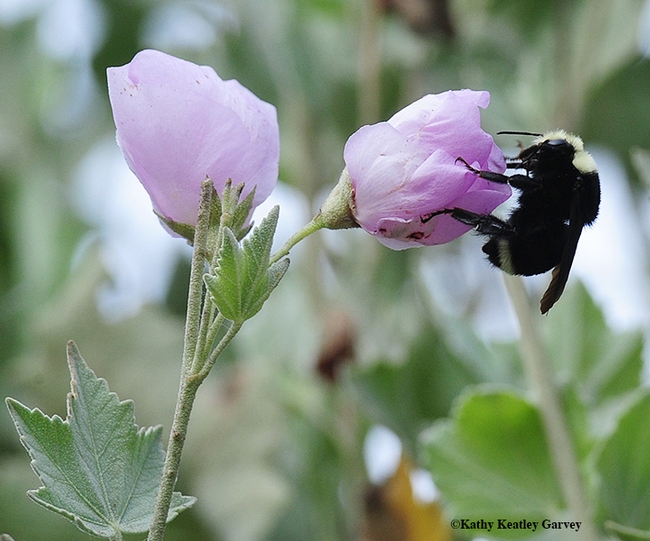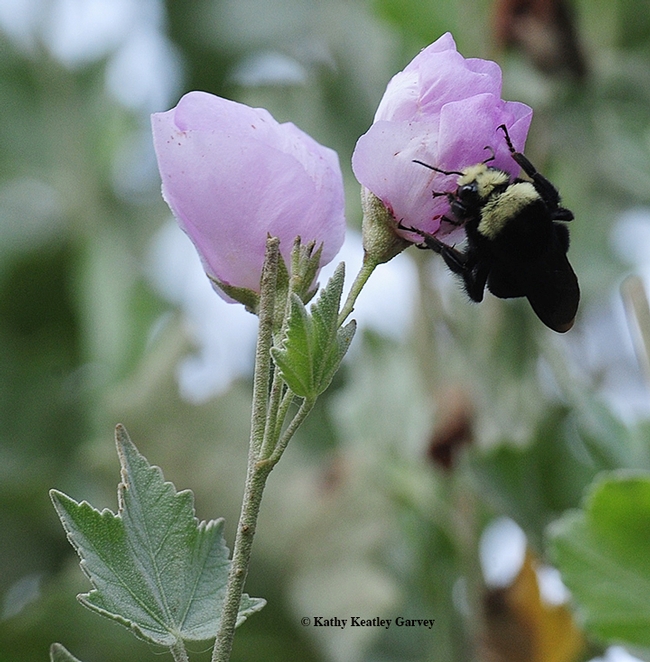Nice to see you!
That's how we greeted our very last bumble bee of 2016.
The yellow-faced bumble bee, Bombus vosnesenskii, apparently came out of hibernation and started nectaring on mallow Nov. 14 at the Natural Bridges State Park, Santa Cruz. We were at the park to see the overwintering monarch butterflies, but it was definitely delightful to see another insect species as well.
Ms. Bombus buzzed from one mallow to the other, keeping her distance from the two-legged park visitors. Once she nearly collided with an overwintering monarch heading for tropical milkweed blossoms.
B. vosnesenskii, native to the west coast of North America and found from British Columbia to Baja California, is an iconic pollinator and also an important pollinator for such crops as greenhouse tomatoes. It's among the bumble bees featured in the book, Bumble Bees of North America: An Identification Guide (Princeton University), the award-winning work of Paul H. Williams, Robbin W. Thorp, Leif L. Richardson and Sheila R. Colla.
When you click on the Princeton site, you'll hear the familiar buzz of bumble bees. It's just like encountering them in a wildflower meadow and listening to them take flight. It's a sound, unfortunately, that we're not hearing that much any more. The world's bumble bee population is declining, and some species are extinct or critically imperiled.
Speaking of bumble bees, did you see the paper, “Bumble Bees of Montana,” published this week by faculty and students in the Montana State University College of Agriculture in the Annals of the Entomological Society of America (AESA)? The scientists researched and compiled the state's first inventory of bumble bees known to live in Montana.
"The first time a bumble bee was recorded in Montana was in the journals of the Lewis and Clark expedition in 1805," wrote Jenny Lavey of the MSU News Service.
Four scientists co-authored the paper:
- Michael Ivie, associate professor of entomology in the MSU Department of Plant Sciences and Plant Pathology
- Kevin O'Neill, professor of entomology in the MSU Department of Land Resources and Environmental Sciences,
- Casey Delphia, MSU research scientist, and
- Amelia Dolan, former MSU entomology graduate student
"Because of Montana's size, landscape diversity and regional junction of eastern and western geographies, when it comes to bumble bees, Montana hosts a diverse, large and globally relevant community of species,” Ivie said in the news release. “Our research shows 28 different species of Bombus, with four more expected to make the list. That's the largest number of bumble bee species recorded for a state in the entire country."
Said Dolan: "It was amazing because we had people collecting specimens across the state, in varying elevations and diverse ecosystems – areas we alone wouldn't have had access to in the time that we had to complete the project. The number of species is representative of Montana's wild spaces and diverse landscapes that host these bees."
When was Bombus vosnesenskii first recorded in Montana? In 1923 (Frison).
If you want to hear more about bumble bees and other bees (some 1600 species of bees reside in California), be sure to attend a free two-hour presentation on "Bee Aware Bee Cause" at 1:30 p.m., Saturday, Jan. 7 by Robbin Thorp at the Rush Ranch Nature Center, 3521 Grizzly Island Road, Suisun. A worldwide expert on bees, Thorp is a distinguished emeritus professor of entomology at UC Davis who continues his research, writings and bee identification work. (See information on the event on previous Bug Squad blog.)
Attached Images:

It looks like...it is! A yellow-faced bumble bee,Bombus vosnesenski, seeking nectar from a mallow blossom at the Natural Bridges State Park, Santa Cruz. (Photo by Kathy Keatley Garvey)

Yellow-faced bumble bee, Bombus vosnesenskii, sipping nectar on mallow on Nov. 14 in Natural Bridges State Park, Santa Cruz. (Photo by Kathy Keatley Garvey)

Side view of yellow-faced bumble bee. (Photo by Kathy Keatley Garvey)